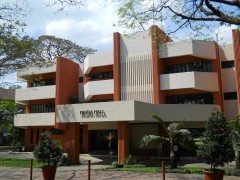A star in the darkest night: Erika Valdueza and her passion for astronomy
October 16, 2010 3 Comments
by Dr. Quirino M. Sugon Jr.
Erika Valdueza and her telescope
Manila Observatory’s largest telescope, two stories high, which was used to obtain the best images the sun 50 years ago before the advent of satellite-based telescopes, lies in the darkness of the Manila Observatory’s Solar Building. Most of the Jesuit scientists are gone, physics students are few, and there is not enough manpower and money to fix the Big One.
But across the sprawling green fields, at the foot of the Manila Observatory’s Administration Building, is another telescope, two feet long, aimed not on the sun but on the moon.
“Look! There it is,” a young lady cried, as she turned some knobs to adjust the telescope’s focus. “It’s lovely.”
Her name is Johanna Erika S. Valdueza, a part-time project research assistant of the Solid Earth Dynamics program at the Manila Observatory and a part-time Remote Sensing graduate student in the University of the Philippines–Diliman. She wished to take up Astronomy, but there was no Astronomy degree in the Philippines when she entered college. She wasn’t also confident in taking Physics and Math as courses for her pre-Astronomy degree. Geology was her second choice next to Physics. She knew that scientists who study solar system bodies by comparing their geologic processes with those on Earth. So she told herself that if she takes up Geology, she would still have a chance to become an astronomer or a planetary scientist someday. That was eight years ago. She is still pursuing her dream now.
There were many of us lining up to get our turn to see the moon. The moon is lovely, dark, and deep. I am not sure if it Erika used a deep-field telescope, but it was the largest moon that I have ever seen, as big as silver dinner plate glittering beneath the lighted candles of a chandelier.
“So this is the moon,” I thought. “Did the Little Prince spent a night there before coming to Earth?”
I saw fields of silvery gold tarnished by pockets of craters. I cannot name the craters but I know thirty-five of them are the names of Jesuit scientists, using the nomenclature first given in 17th century by Fr. Giovanni Battista Riccioli, S.J. and Fr. Francesco M. Grimaldi, S.J.
Some of us went to another telescope also set up by Erika. It looks like a toy: a red spherical ball with a cylinder mounted on it. On the cylinder are the lens for collecting light and the eyepiece. The telescope can be tilted at any elevation angle and in any compass direction. The image is smaller than the previous telescope, but it is good enough.
Erika has six telescopes–three refracting and three reflecting. Her first one was obtained last 2005. Four of her telescopes were given by her parents. The other two she acquired when she started to work. Erika uses her telescopes for her hobby in astrophotography. She photographs not only the moon, but also the sun, stars, and planets. Many of her pictures she upload in her blog: http://theskyabove22.wordpress.com/. Several of them were featured in other websites, such as the Amateur Astronomy Picture of the Day, Earth Science Picture of the Day, and spaceweather.com (a list is here). Here is a sample of her video of the lunar occultation of Venus in You Tube.
Erika was nominated as the Astronomy Photographer of the Year in the Royal Observatory, Greenwich last 2010. She was shortlisted, but was not able to make it this year. But this does not stop her from continuing with what she loves to do most.
“Astronomy is my lifelong passion,” Erika said. “I can’t imagine my life not doing anything related to Astronomy.”
Erika is a member of the U.P. Astronomical Society’s solar eclipse expedition to Jianwe, China last July 2010 and a member of the Astronomical League of the Philippines (ALP) in charge for monitoring sunspots. She is also one of the volunteers for the Gallia Asteroid Occultation Project of the Astronomical Society of the Philippines (PAS) and NASA’s Johnson Space Center Astronomical Society.
Before October ended this year, Erika said goodbye. She would be leaving the Observatory to work full-time as a research assistant in the National Institute for Geological Sciences (NIGS) in U.P. Diliman. We her friends here at the Manila Observatory gave her a small party for her birthday. We gave her a little token (her picture above with a telescope) with a card containing our best wishes. She wore the same pink shirt. It’s a red letter day.
“I will miss you all,” Erika said softly as tears run down her cheeks. “I will miss the birthday parties.”
“It is ok,” one of us said. “You can still set up your telescopes here at the Observatory. During birthdays, you are still invited to come. You remain as part of the Manila Observatory.”
Erika smiled. The little girl of 11 years who first gazed at the kite-like pattern of stars in the Big Dipper and who learned how to navigate the night sky and the names of the constellations is now one of the brightest stars in Philippine Astronomy.
Farewell, Erika, “Stella Gaze”. To the stars!
Birthday and Farewell party for Erika Valdueza at Manila Observatory. From left to right: Randell Teodoro, Nino Uy, Genevieve Lorenzo, Dr. Faye Cruz, Emmi Capili, Dr. Celine Vicente, Marianne Vasquez, Erika Valdueza (in pink), Dr. Quirino Sugon Jr., Sandee Recabar, Melissa Cruz, Donna Lyn Sanidad, and Carina Sarmaniego.



